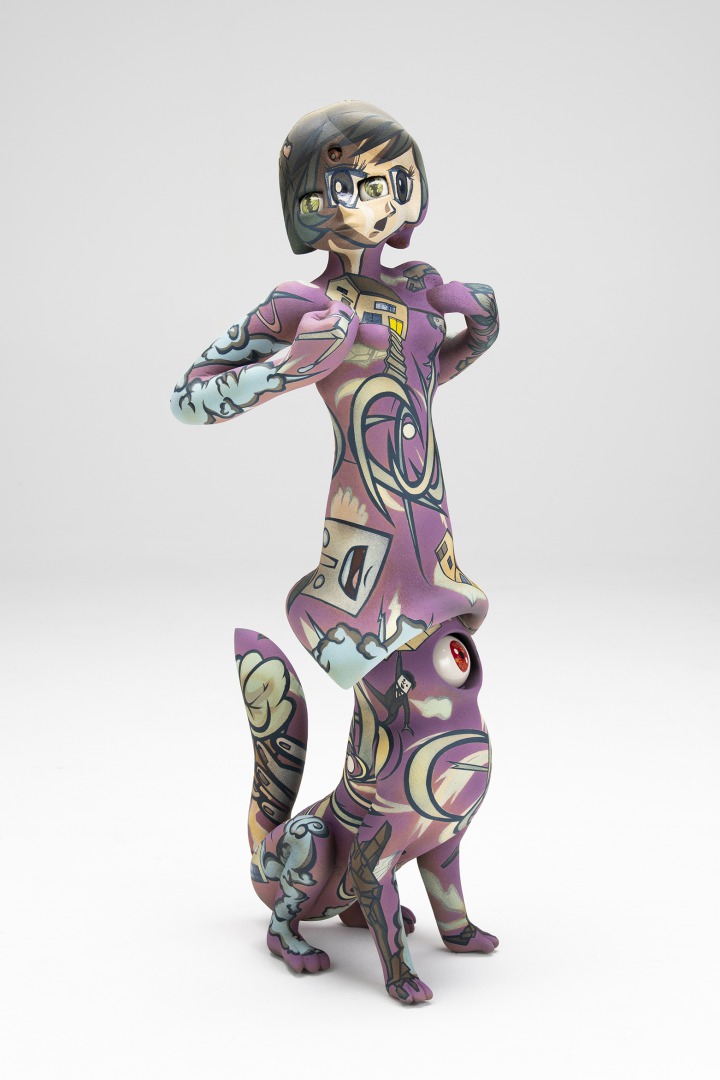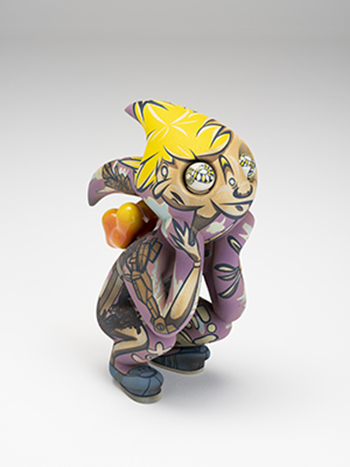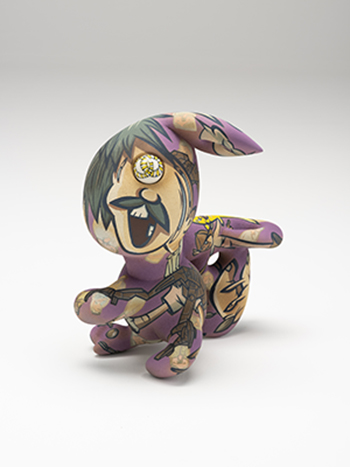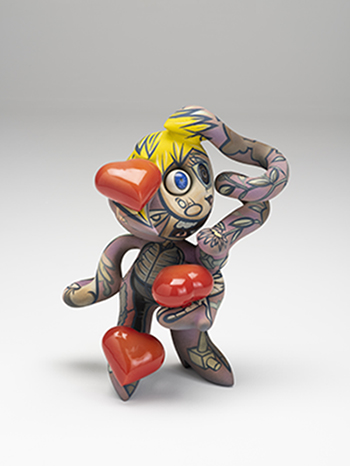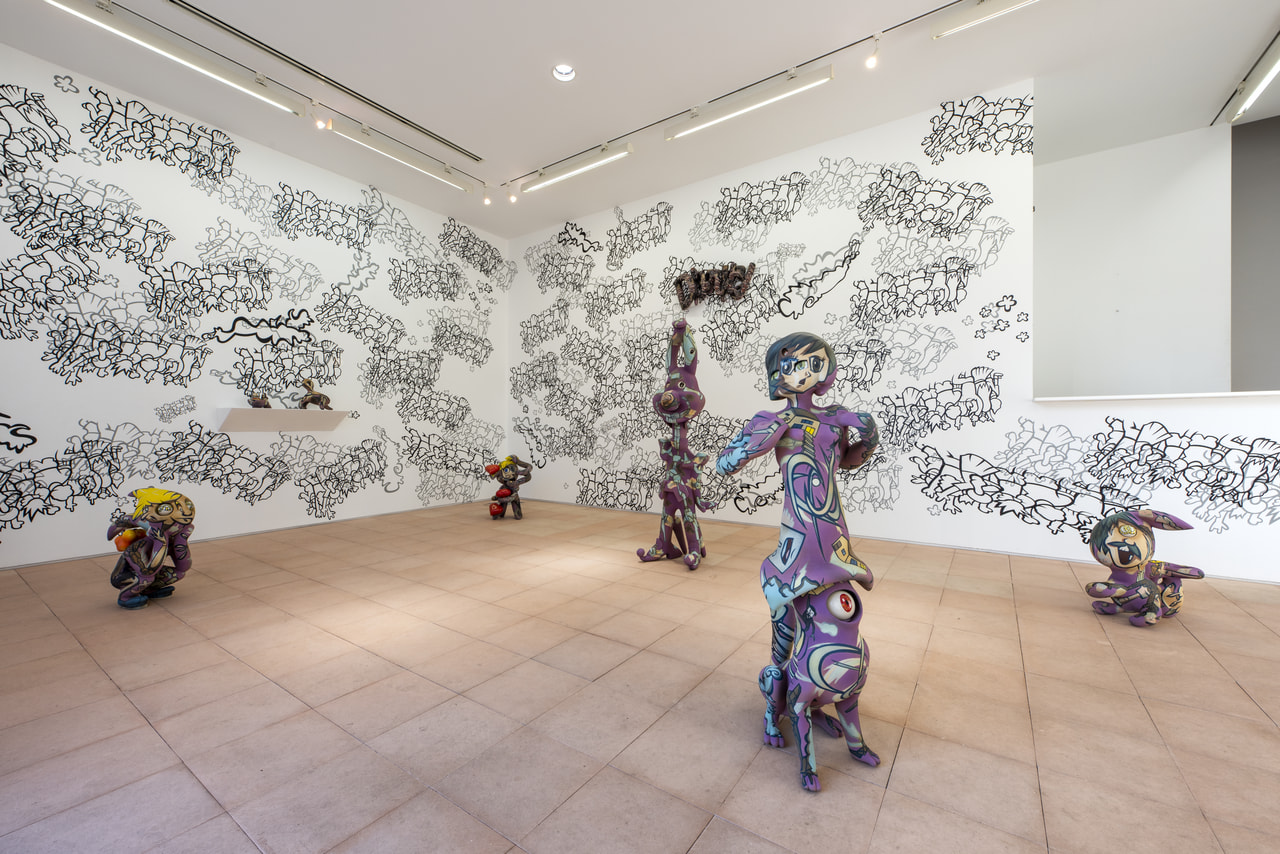Imura art gallery is pleased to announce "Hands and Visionamusement," an exhibition by Takashi Hinoda. Hinoda has worked with clay for about thirty years. During those three decades he has developed a dynamic freehand style, using distinctive colors and shapes, and established signature two-dimensional expressions that cover the whole surface of his ceramic forms. His exploration of the potential of ceramic art pivots around these elements. This exhibition marks the launch of shushikikeigaku, a term that Hinoda has invented as a key concept in the search for a new understanding of visual art, transcending the art/crafts framework. In English, it can be rendered as visionamusement, or as hands-on visionamusement. The materiality of a real physical presence, along with the material coloring that connects to it in a way that goes further than superficial existence, are vital to the artist's practice. In this presentation he takes these characteristics deeper, condensing them into the works that he exhibits. The result is an exciting exhibition in which Hinoda takes up the challenge of a new frontier.
Works by Hinoda will also be exhibited at the Museum of Modern Ceramic Art, Gifu from December 21, 2019 to May 10, 2020 in the "Give Me a Name!" exhibition in the museum's Gallery II. This is an exhibition of works selected from the museum's collection, presenting highlights and new accessions as part of a project to commemorate the beginning of Japan's Reiwa Era.
=====
Hands and Visionamusement *
My work has consistently involved three-dimensional art, created using ceramics. But although ceramics provide the fundamental base, I have always regarded my practice as one of the possible approaches to contemporary visual art. For me, ceramics are the most important characteristic because as a material they have the potential to persist over time as a semi-permanent relic. Another important characteristic comes from the production process, in that I use my hands to work the material, the substance that becomes the eventual work. This process is a form of manual labor, and no concept can fully replace it. My approach involves more than simple nostalgia for manual work; it also has the sensuality and sense of resistance that comes with an empathy between things and human senses, and the interaction that is accompanied by feedback. These are elements that are already being lost from contemporary lives--which are overly slanted toward convenience--but I am convinced that heading in the opposite direction and working with your hands has a more positive meaning.
I see my own work as being in a framework that is distinct from the modern-day art/crafts duality, and from the area of contemporary art that makes substantial use of texts and research, video and similar methods that are based on concepts. Feeling the need for a phrase to describe the sort of work I produce, I recently settled on the term 'visionamusement,' or 'hands-on visionamusement.' This solo exhibition has provided the opportunity to launch the term by incorporating it into the title. Looking back at the history of art and crafts in Japan, the terminology adopted for the frameworks that delineate the arts corresponded to Western concepts such as 'Art' and 'Kunst.' When these terms were applied to Japan's pre-existing aesthetics, areas such as shokogei (miscellaneous crafts) and calligraphy were left suspended, without a natural place in the frameworks. This is a well-known historical fact. Grounded in this situation, Hands-on Visionamusement is my attempt to gaze again at colors and shapes, assessing their value to me without going back to pre-modern circumstances.
Early in the 1970s, when Brazil was under military administration, and even music was censored, Milton Nascimento released an album entitled Milagre dos Peixes (Miracle of the Fishes), which avoided censorship by having virtually no comprehensible lyrics. That story left a deep impression on me. Apart from the political elements, I could see that it was evidence that he had understood the potential power that sounds intrinsically possess. Colors and shapes can surely also have similar effects. They were originally languages in their own right, and at times, they can give viewers a trembling catharsis, enough to greatly surpass verbal language.
When you look at the colors in video, they always seem to be missing something. I think it's because they are based on light. Light acts on the conscious mind, which provides a footing for concepts. In contrast, the colors of ceramics are revelations, incarnated as things. They have weight, shade, and they incorporate substances things like lye. And I believe that within them, they conceal triggers that induce us to reconsider our own physicality.
(* 'visionamusement' is a term coined by the artist)
Takashi Hinoda
この度イムラアートギャラリーでは、日野田崇個展「手と色形楽」を開催いたします。
手と色形楽
私は、一貫して陶による立体造形に取り組んできました。その姿勢は、陶を基盤にしながら、あくまで現代の視覚造形のひとつの在り方を追求するものです。私が陶の最も重要な特質と考えているのは、時間を超えて「半永久的に遺物として残り続ける」可能性があるということです。そして制作においては、もうひとつ、物質である素材と、それを手で加工していくことを重視しています。それは労働の一種ですが、それを概念に完全に置換することはできません。そこには、単に手仕事への懐古的な郷愁にとどまらない、「もの」と人間の感覚の交感に伴った官能性や抵抗感、循環をともなったやりとりがあります。利便性に偏った現代人の生活はこのような要素をどんどん失くしていく方向に向かっていますが、それと逆行する手の労働にはもっと積極的な意味があると思っています。
近代的な「美術/工芸」のような二元論や、概念を基盤にしたテキストやリサーチ、映像的な手法を多用するContemporary Art の領域とは別の枠組みを自身の制作に想定するために、最近では「手色形楽(しゅしきけいがく)」という言葉を使っています。今展ではとくにその用語を展覧会の表題に押し出しています。" Art" や" Kunst" といった西洋の概念と用語に対応する枠組みを、あとから当て嵌めたがために、諸工芸、書などの居場所が宙ぶらりんになってしまったのは周知の史実です。「手色形楽」とは、そのような状況の中で、前近代的な復古に走ってしまうことなく、自分にとっての色やかたちそのものの価値をもう一度見つめていこうという試みです。
1970 年代の初頭、ブラジルが軍事政権下にあった時代に、当局の歌詞検閲をかわすために、ミルトン・ナシメントが「魚たちの奇跡」の収録曲のほとんどをスキャットで歌っていたという事実は、私にとって重要です。このエピソードは政治的な要素も持っていますが、本来の「音」の潜在力を彼が知っていたことの証左のように思えるのです。色やかたちにもそれと同じような作用があるのではないでしょうか。色とかたちは本来、それ自体がひとつのことばのはずであり、ときにはヴァーバルな言語をはるかに凌駕するほどの戦慄的なカタルシスを見る者にもたらすことがあります。
私にとって、映像の色彩がなにかいまひとつ物足らなく感じるのは、おそらくそれが「光」をベースにしているからだと思っています。「光」は概念の足場である意識に働きかけます。それとは対照的に、陶の色彩は「もの」に受肉した啓示であり、重さや陰、灰汁のようなものを含んでいます。そこには私たちが自らの身体性を再考するきっかけが潜んでいると信じています。
日野田 崇
歪み、デフォルメ、ブレ、反復、と
生命体とも言い切れない存在。頭部、胴体、手足のようなパーツはデフォルメされ歪み、触手のようにしなやかに伸び、分裂し変態しながらもバランスを保ち立つ。表面のイメージもまた同様の特色を持ちつつ、かたちに寄り添いながらもブレてまた反復する。このように日野田崇の作品群には、歪み、デフォルメ、ブレと反復という特徴が顕著である。これらの特徴が、立体というかたち、イメージ、展示される場に、絡み合いながら展開する。
日野田は制作のプロセスにおいて、スケッチやマケットのようなものを予め用意せず、直接土に向かう。それは感覚だけを頼りに手を動かす身体的なものである。日本の漫画、アメリカン・コミック、グラフィティ、イラスト、町中でみかけた広告、看板、浮世絵、さらには大津絵など多岐にわたるイメージから影響を受けており、フォルムはぬるりとしなやかな変形が施され、イメージはクリアな黒いアウトラインで塗り分けられる。
日野田は自身の制作過程の別の影響要素として音楽を挙げる。ジャンルにこだわらず即興的なものを好み、そこで体得する感覚を重要視する。なるほど、フリースタイルなリズム、グルーヴに自らの直感を乗せ、土に直接手で触れ、成形、色を施し、素材との交信を重ねる過程で、時に無意識も意識するかのように、記憶や経験と身体とが一体となり、立体というひとつの姿へと変貌をとげる。この勢いは立体に留まらず、台座、床、壁面へと展開する。この時、日野田は与えられた場の内にイメージをレイアウトしなければならない。だが視点を変えれば、この構成により展示空間は、四方八方にぶつかり跳ね返るリズム、叫び、そのエコーの増幅と拡散の場と化すのだ。このように捉えると、歪み、デフォルメ、ブレと反復は、予定調和に収まりきらない、より動的なるものの連鎖の表れである。
この歪み、デフォルメ、ブレと反復は現代を生きるひとりの思考の投影でもある。土による成形、マスキング・テープを用いてフリーハンドで分割された面に極細のノズルから自身の息で塗料を吹き付けるといった作業等の幾度もの繰り返しは、制御と忍耐そして時間を要するものである。さらに焼成による外形や色の変化は作家による制御を裏切る。作家はその都度、決断と選択を迫られる。こうした工程は、日野田にとって、既に混沌とした社会に生きる自身の全身全霊を創造に投げ入れる行為に均しい。あたかも、自然環境と日常の営みが危機的状況にある現代を受けとめ、当事者としてこの社会といかなる関係を構築できるか模索するかのごとく。
一貫して土という物質を用い、身体と素材とのダイレクトなコミュニケーションによる制作にこだわり抜く所以のひとつに、このように、一方に直感と即興という内なる衝動と速攻性、他方に行為の制御、忍耐、反復という外的要因を伴う作業といった二極にあるものの相互共存の必然性があるからではないか。作品タイトルがテーマあるいはコンセプトであり、かたちと色はその描写という一方向のみに集約されがちだが、違う。直感、触知、記憶、素材と生成のプロセス、思考、言葉-これらが作家の身体を通して密接に関わり、同時並行的に、時にそれぞれの要素が交互に通奏低音となり、その上で他の要素による演奏が進行するかのように、かたちと色が紡がれるのである。
丸みのあるフォルム、表面のざらつきは皮膚のようでもあり、卵の殻のような質感を帯びる。イメージは滑らかに吸い付くように表面に延びる。こうして現前する造形は、支配と管理に好都合なシステムに組み込まれ、身動きが取れない現代人の姿。だが、この世界に今もなお未来を抱くことが出来るのであれば、この先が見えず抑圧された状態からの解放を予見するものであってほしい。
北出智恵子
(キュレーター/美術批評)
